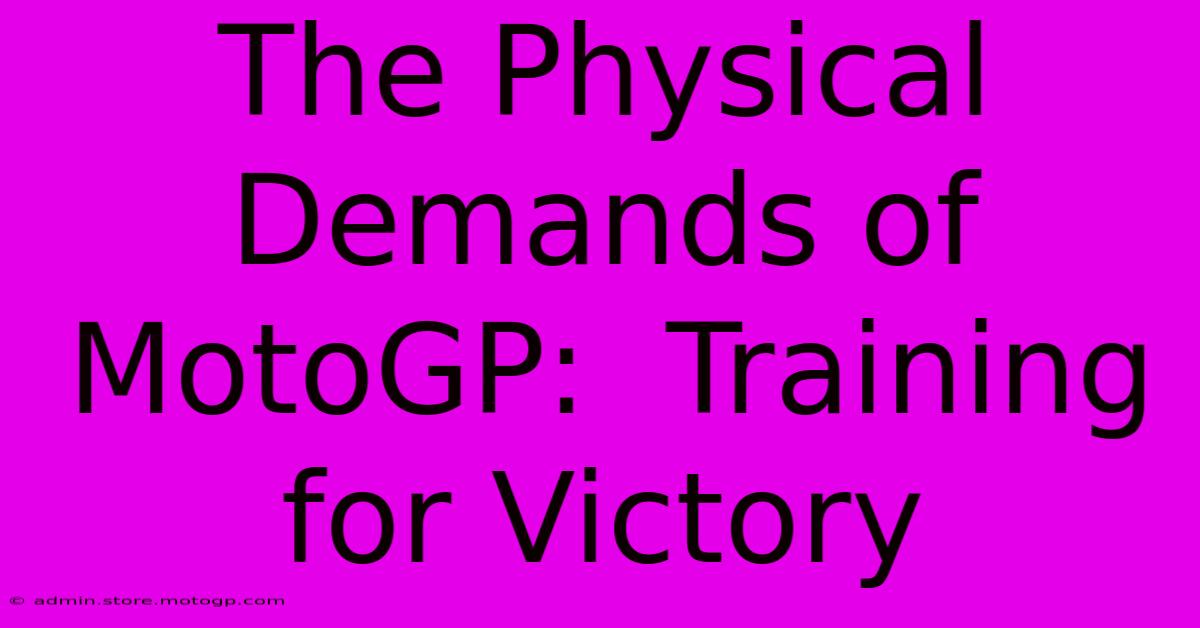The Physical Demands Of MotoGP: Training For Victory

Table of Contents
The Physical Demands of MotoGP: Training for Victory
MotoGP racing isn't just about speed and skill; it's a brutal test of physical endurance. The riders push their bodies to the absolute limit, enduring intense G-forces, extreme temperatures, and demanding physical exertion for extended periods. To compete at the highest level, MotoGP riders require a meticulously planned and rigorous training regime. This article delves into the physical demands of MotoGP and the training strategies employed by these elite athletes to achieve victory.
The G-Force Factor: A Constant Battle
One of the most significant challenges MotoGP riders face is the relentless exposure to G-forces. During cornering, acceleration, and braking, these forces can reach incredibly high levels, putting immense strain on the neck, shoulders, and core muscles. Sustained exposure to these forces can lead to fatigue, muscle strain, and even loss of consciousness if not properly managed. This necessitates specific training to strengthen these critical muscle groups and improve their resistance to these powerful forces.
Neck Strength: The Unsung Hero
The neck muscles are particularly crucial in MotoGP. They are responsible for supporting the head against the considerable lateral and vertical forces experienced during racing. Specialized training, including isometric exercises and resistance training with specific neck-strengthening devices, is essential for riders to maintain control and prevent injury.
Core Strength: The Foundation of Control
A strong core is fundamental for stability and control on a MotoGP bike. The core muscles act as a central pillar, enabling the rider to maintain balance, absorb shocks, and react quickly to changes in track conditions. Riders engage in intense core workouts, focusing on exercises such as planks, Russian twists, and medicine ball throws to build and maintain this crucial strength.
Beyond G-Forces: Other Physical Demands
The physical demands extend far beyond just G-force resistance. MotoGP riders also experience:
- Extreme Cardiovascular Strain: The intense pace of a race demands exceptional cardiovascular fitness. Riders' hearts and lungs must work tirelessly to supply oxygen to the muscles, demanding extensive cardio training, including cycling, running, and swimming.
- High Temperatures and Dehydration: The intense heat generated by the engines and the environment itself leads to significant dehydration. Maintaining proper hydration and electrolyte balance is vital to prevent muscle cramps, fatigue, and impaired performance.
- Muscle Endurance and Strength: Riders need exceptional muscle endurance to withstand the prolonged physical strain of a race. Strength training is critical, focusing on exercises that build strength and power in the arms, legs, and core.
- Fine Motor Skills and Reaction Time: Operating the controls of a MotoGP bike requires exceptional fine motor skills and lightning-fast reflexes. Riders undergo rigorous training to hone these skills, often incorporating simulator sessions and reaction time drills.
Training Regimen: A Holistic Approach
A typical MotoGP rider's training regimen is a carefully balanced program that encompasses:
- Cardiovascular Training: High-intensity interval training (HIIT), endurance running, and cycling are cornerstones of their cardio program.
- Strength Training: Weightlifting, plyometrics, and functional exercises focus on building strength and power in all major muscle groups.
- Flexibility and Mobility Training: Yoga, Pilates, and stretching routines enhance flexibility and prevent injuries.
- Specialized Training: Neck strengthening, reaction time drills, and simulator sessions cater to the specific demands of MotoGP racing.
- Nutrition and Hydration: Maintaining optimal nutrition and hydration is crucial for peak performance and recovery.
The Mental Game: A Crucial Component
Beyond the physical demands, MotoGP racing requires immense mental fortitude. The pressure of competition, the risks involved, and the need for unwavering focus are all major challenges that require significant mental resilience. Mental training techniques, including mindfulness and visualization, play a crucial role in preparing riders for the mental battles they face on and off the track.
Conclusion: A Symphony of Strength and Skill
Competing at the highest level of MotoGP requires a remarkable combination of physical prowess, technical skill, and mental strength. The intense physical demands necessitate a highly specialized and rigorous training regime, encompassing cardiovascular fitness, strength training, flexibility, and mental preparation. Only through this unwavering dedication to training and a holistic approach to fitness can these elite athletes achieve victory on the track.

Thank you for visiting our website wich cover about The Physical Demands Of MotoGP: Training For Victory. We hope the information provided has been useful to you. Feel free to contact us if you have any questions or need further assistance. See you next time and dont miss to bookmark.
Featured Posts
-
Sprint Race Results Analyzing The Winners Strategies
Feb 19, 2025
-
Moto2 The Ultimate Test Of Skill And Courage
Feb 19, 2025
-
Circuit Of The Americas Store Find Your Perfect Fit
Feb 19, 2025
-
Moto Gp Helmets For Sale Designed For Speed Demons
Feb 19, 2025
-
Tnt Sports Moto Gp Experience The G Force
Feb 19, 2025
